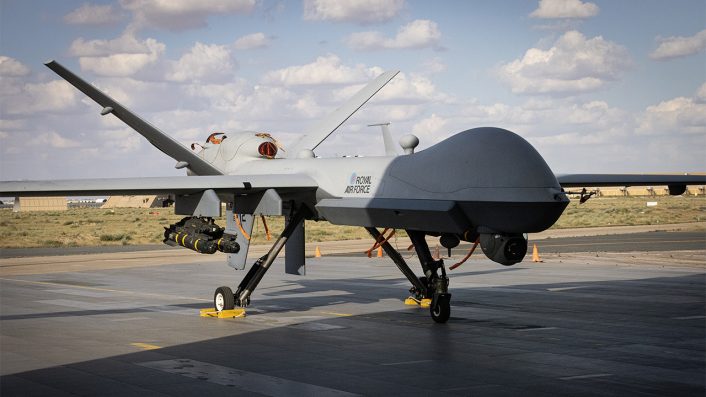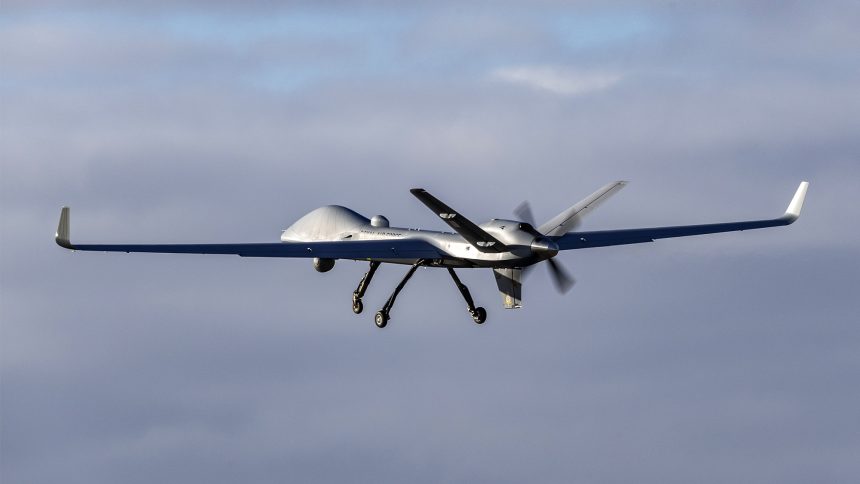The Royal Air Force has begun assurance testing and operational training for its MQ-9B Protector RG1 UAVs ahead of the new aircraft replacing its MQ-9A Reaper predecessor on operational sorties.
In a post on social media, the Royal Air Force (RAF) confirmed that preparations are underway to allow the Protector RG1 – the UK designation for the MQ-9B SkyGuardian – to undertake its first frontline missions. The type made its maiden UK flight in 2023, then began a sustained series of flight testing in early 2025 which culminated in the aircraft receiving a military type certificate from the UK Military Aviation Authority, allowing flights outside of specially segregated airspace.
This new phase of trials will verify the aircraft type’s ability to reliably perform all required operational tasks, and ensure that operators have been trained to a sufficient level of proficiency. While the delivery of full operating capability before the most recent intended sundown date for the MQ-9A Reaper seems optimistic, the prospect of frontline MQ-9B operations is now very much within reach. The most recent stated withdrawal date for Reaper was ‘later in 2025’ with indications from sustainment contracts suggesting a date of Sept. 30.
If Protector does indeed replace Reaper by the end of the year, this would remarkably peg the project only one year behind projections made in 2019. The new drone was officially commissioned into RAF service in June 2025.
The 🇬🇧 have officially welcomed the Protector RG Mk1, a next-generation Remotely Piloted Air System (RPAS), into service
NATO continues to improve force readiness, modernise command and control & strengthen integrated air and missile defence #NATOSummit
📷Royal Air Force pic.twitter.com/V15tKYvkLd
— NATO Air Command (@NATO_AIRCOM) June 25, 2025
The RAF says that the Protector will be replacing the Reaper on Operation Shader, which is the UK’s military intervention against Daesh (also known as ISIS, ISIL, or Islamic State) in Iraq, Syria, and the wider Middle East. RAF MQ-9 Reapers have been deployed for Shader permanently since the operation commenced in 2014, flying huge numbers of intelligence, surveillance, and reconnaissance (ISR) sorties as well as taking direct interventions with Hellfire missiles and GBU-12 Paveway guided bombs. The most recent publicly announced airstrike involving the Reaper during Operation Shader was in February 2025, when a Hellfire missile was used to target a known Daesh militant.
Airstrikes undertaken as part of Operation Shader have slowed dramatically in recent years with the general collapse of Daesh. The group lost virtually all of its territory in Iraq and Syria and are now largely reduced to operating in small clusters of militants. While the number of strikeable targets has decreased, persistent ISR is still utilised throughout the region to protect against further attack and monitor the group’s ongoing operations.

Operation Shader
In September 2024, the UK announced that Operation Shader was due to be wrapped up over the following 12 months, reflecting the vastly changed nature of the situation on the ground. Given that this deadline has now passed, it would seem with this announcement that the operation has been granted a reprieve. It was likely that regardless of Operation Shader’s status the forward deployed Typhoons and associated aircraft at RAF Akrotiri would remain in place to protect UK interests in the area amid regional turmoil. The Typhoons have also occasionally been utilised to provide escorts to RAF ISR aircraft over the Black Sea, monitoring the Russia-Ukraine conflict.
The location of the UK’s deployed MQ-9 Reapers in the Middle East has never been officially disclosed, but it is publicly believed that they primarily operate from Ali Al Salem Air Base, Kuwait – geolocation using publicly available imagery has confirmed their presence at the station. All flying of the aircraft outside of take-off and landing is controlled by operators at RAF Waddington back in the UK. A detachment of RAF personnel also previously operated drones using ground control stations (GCS) at Creech Air Force Base, Nevada, alongside U.S. Air Force Reaper crews, but this arrangement ended in 2022 with the disbandment of 39 Squadron.
RAF MQ-9 Reaper drone at Ali Al Salem Air Base, Kuwait https://t.co/JNsSiBq1G5 https://t.co/04RUxJsdm4 pic.twitter.com/RVq7FepmSn
— Samir (@obretix) May 6, 2023
Protector RG1s will likely fly from the same forward operating base, though notably unlike the Reaper they will also be able to fly within UK airspace and from Waddington directly. Without the military type certificate which allows the Protector to operate in civilian airspace, the Reaper has never been able to operate from UK soil. UK-based Protectors, if not required for operations overseas, could lend assistance in various military and civilian taskings, including maritime surveillance and search and rescue, and additionally take part in training exercises which have previously necessitated the use of manned surrogate aircraft.
16 Protector RG1s have been ordered for the RAF, with at least 10 aircraft having been delivered to RAF Waddington. The Royal Navy is reportedly considering a variant of the aircraft for its airborne early warning requirement, replacing the Merlin HM2 ‘Crowsnest’. This would likely be in the form of the MQ-9B STOL, which has already been tested on board the UK’s Queen Elizabeth class aircraft carriers. In addition to the UK, the MQ-9B has also been ordered in Europe by Denmark, Belgium, and Poland.









